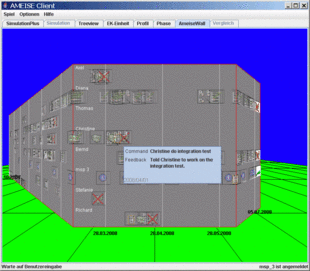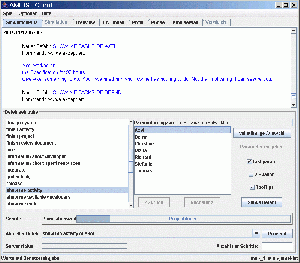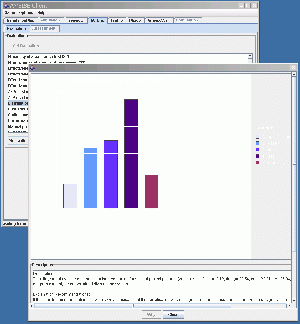About The Project: Difference between revisions
No edit summary |
No edit summary |
||
| Line 65: | Line 65: | ||
* Standard model. | * Standard model. | ||
This model corresponds to the basic Quality Assurance Model of Stuttgart QA200. | |||
The task is here within 9 months and 225,000 EUR budget to perform a 200 | |||
[[http://en.wikipedia.org/wiki/Function_point Adjusted Function Point]] project. | |||
* '''Further models ''' | * '''Further models ''' | ||
* Maintenance model. | * Maintenance model. | ||
This one, created at the University of Linz model connects to the standard model, | |||
but the focus is on the project to be carried out by a maintenance phase. | but the focus is on the project to be carried out by a maintenance phase. | ||
At irregular intervals it comes to maintenance tasks (corrective and preventive), | |||
being managed by the project manager. | being managed by the project manager. | ||
| Line 98: | Line 98: | ||
For an Internet / intranet connection is to be provided accordingly. Depending on the application, the technical requirements are different. The following rules of thumb can be given: | For an Internet / intranet connection is to be provided accordingly. Depending on the application, the technical requirements are different. The following rules of thumb can be given: | ||
* '''Client'''. The client is available as a Windows executable or as a Java application (for Linux, MacOS, Solaris, and Windows). The only requirement are the above operating systems, internet access (at least to the AMEISE Server) and Java JDK 5 | * '''Client'''. | ||
The client is available as a Windows executable or as a Java application (for Linux, MacOS, Solaris, and Windows). | |||
The only requirement are the above operating systems, internet access (at least to the AMEISE Server) and Java JDK 5 | |||
* '''Server'''. The server consists of three sub-components: the database, the load distribution manager and one or more simulation cores: | * '''Server'''. | ||
The server consists of three sub-components: the database, the load distribution manager and one or more simulation cores: | |||
* Database. | |||
* Load distribution manager (LBMMgr). This is also available for Linux, Solaris and Windows as a Java application. Java JDK 1.4 is required, such as 50MB of RAM and 10MB of hard disk space. | What is needed is a free SQL database mysql in version 4.1 (innodb-Type to be transaction-safe). | ||
As a rule of thumb applies: each simulation (users) requires 60MB of disk space. | |||
* Load distribution manager (LBMMgr). | |||
This is also available for Linux, Solaris and Windows as a Java application. | |||
Java JDK 1.4 is required, such as 50MB of RAM and 10MB of hard disk space. | |||
* Simulation core (wrapper). | |||
Per wrapper, 500MB RAM and 10 MB of disk space are required. | This is available for Linux, Solaris and Windows as a Java application. | ||
Java JDK 1.4 is required (note, JDK 5 is not allowed!). | |||
In order to increase the performance several wrappers should be runned, as a rule of thumb: | |||
for each 5 clients, a wrapper should be installed. | |||
Per wrapper, 500MB RAM and 10 MB of disk space are required. | |||
== More questions? == | == More questions? == | ||
Revision as of 23:34, 25 April 2013

The AMEISE-System provides students of informatics,business informatics and economics as well as subject-related university or college-studies, the ability to collect project-managment experience on a simulator. Critical situations can be defined and trained with AMEISE without getting a real project in danger.
Future project-leaders can execute projects in a few hours that would normally take several months. They also get confronted with typical problems of projects and should solve them.
Currently the AMEISE system offers three different models: a Beginner-Model (Mini model, with less requirements), a Standard model (with a particular focus on quality assurance), and a Maintenance-model (which is based on the activities after delivery the product). AMEISE is more than a simulator. The instructor can activate many different components for example the advisor or evaluation components. A special feature is the ability to simulate at certain points reset (rollback). Thereby different variants can be tested by the project leader(for example change developers or using a different strategy) and then the results can be compared.
Started in 2001 as part of a nml project from bm:bwk,AMEISE is used on several universities and colleges in austria,germany and the magreb region.The heart of the AMEISE-system is (SESAM)which was developed at the university of stuttgart(Prof. Jochen Ludewig)and related Quality assurance models (also referred as QA-models).
Components of the project
AMEISE is a Client-Server System, which can be executed locally on a computer or distributed in intranet or internet. The system is designed so that even unstable compounds have no effect on the simulation.As a trainee you can use the AMEISE client to manage a virtual project what means to distribute tasks,to have an overview about the project and of course to deliver your product at the end of the simulation run.
Client

The AMEISE client provides a graphical interface for trainees and designed as a java-application it runs virtually on every platform. Comment inputs and feedbacks are usually text-based, but to make the inputs more comfortable there is also a mouse-based version available:
- SimulationPlus. After successful authentication, a window appears which contains the feedback from the simulator in the upper part and the available commands in the lower part. Commands can be entered and responses can be observed and you are able to advance the simulation time per day.
Project leaders can choose between different commands to lead hired developers or ask about their current status. You can choose the command you need really random and arbitrary at any time. That means you can cause a reasonable or unreasonable activity. As in reality you have free choice but you have to consider that your actions can have positive or negative effects on your project run.
The AMEISE Client provides an interface for the simulator but also many supervisor components support the learning process during or after the simulation run and can be activated or deactivaded by the instructor.
- Explanation component - Advisor. This component imitates an experienced employee, who you can ask questions about your project
This employee looks at your performance and gives feedback about single project phases and the product. This component is activated during a simulation run by default.

- Explanation component - Evaluation. This component analyses your current project status and generates diagramms and tables to give you an overview about your project run. Here you can get information about your performance, the employees use and the quality of your interim - and endproducts. Usually this component is getting activated after the project, allowing self-analaysis of the simulation run or analysis by the intstructor.
- Friendly Peer. This component also imitates an experienced employee but is implemented as a seperate process. You can use the friendly-peer as an observer during the simulation. The friendly-peer gives you advices when difficult situations must be solved. The component is disabled by default and can be enabled by the instructor.
To get an overview you can use the SimulationPlus component which offers you even more views of the project run.
- AmeiseWall. Für einen besseren zeitlichen Überblick kann man mittels dieser Komponente die gesetzten Aktivitäten in Form einer Perspective Wall betrachten. Nach Mitarbeiter geordnet erscheinen Aktivitäten als kleine Grafiken.
- TreeView. Die AMEISE ermöglicht nicht nur die einmalige Simulation eines Modells. Es entstehen somit verschiedene Pfade die ein Projekt nehmen kann. Die TreeView Komponente stellt den Simulationsverlauf grafisch in Form eines Baumes dar.
- PhaseView. Im Gegensatz zum TreeView, welcher jeden Simulationsschritt darstellt, bietet der PhaseView eine phasenorientierte (vorgehensmodellabhängige) Sichtweise an. Balken repräsentieren begonnene und abgeschlossene Phasen im Projekt.
Server
Core of AMEISE is the AMEISE-server, a java-application with is SQL-Database. The server consists beside the database of two different applications, the simulation core and the load balancing manager.
- AMEISE Wrapper. This component consists the simulation core. The simulation core is a one user system. In the wrapper, this core is embedded in a java application and made multi-user able. Here too, data are written into the database. Depending on the workload, the AMEISE operate several wrappers parallel and thus simultaneously edit remote client requests faster
- LBMMgr (Load Balancing Manager). Actually, a load distribution manager who ensures that each AMEISE-client has free and particularly fast simulation engine available. The LBMMgr is also the interface to the outside and does the required declaration of the component database requests.
Models
Core of AMEISE (as well as of SESAM) are the simulation models and its explaining texts. The in AMEISE used models are largely based on the quality assurance model which was designed in Stuttgart. The approach underlying model is a linear model which places value on the item quality and quality assurance measures. The rules underlying the model are based on a wide range of data, are empirically rich and validated several times.
- Quality assurance model
* Mini model. This model serves to get acquainted of the simulator and the user interface. The goal is a greatly reduced complexity in the task (Project with only 3000 LOC, 3 fixed employees, sufficient time and budget) properties of the simulation environment to learn the simulation environment. The model was defined at the University of Klagenfurt.
* Standard model. This model corresponds to the basic Quality Assurance Model of Stuttgart QA200. The task is here within 9 months and 225,000 EUR budget to perform a 200 [Adjusted Function Point] project.
- Further models
* Maintenance model. This one, created at the University of Linz model connects to the standard model, but the focus is on the project to be carried out by a maintenance phase. At irregular intervals it comes to maintenance tasks (corrective and preventive), being managed by the project manager.
The history
The idea of AMEISE was developed as part of a project bidding nla (New Media in the teaching of bm:bmwk, Austria) in 2001 and at a presentation of SESAM, University of Stuttgart (Prof. Jochen Ludewig). The aim was to expand SESAM insofar, that the use in large groups, also unmaintained and not accompanied to enable and automate the analysis of the results. Around the university of Klagenfurt (Prof. Mittermeir, Dr. Bollin) came the FH Kärnten (Prof. Hochmüller), the university of Linz (Prof. Croust) and the university of Stuttgart (Prof. Ludewig) to the team.
From 2001 to 2003, there was the development phase, in which a client-server architecture was built. The use of free software (GPL based) and Java enabled broadest possible platform independence, but also led to many technical problems in the maintenance phase which could be solved within the framework of the maintenance phase from 2003 to 2006Despite the project ends in 2006, the AMEISE is further developed and is based on several project and dissertations.
Since 2002, the AMEISE is at the project sites in courses in use and partially already enshrined in the respective curriculum. Since 2004, AMEISE is used at partner universities in Germany . Since 2004, AMEISE is also part of an EU-MEDIDA project and is used in the Maghrebi region.
Technical Requirements

AMEISE can be used in two different ways. Either one uses the AMEISE Server of the University of Klagenfurt and engages only by the client to the server to, or you install the server locally. AMEISE can be installed for demonstration purposes auf on a single computer (including laptops) , but for use in a course a distributed system is recommended. For an Internet / intranet connection is to be provided accordingly. Depending on the application, the technical requirements are different. The following rules of thumb can be given:
- Client.
The client is available as a Windows executable or as a Java application (for Linux, MacOS, Solaris, and Windows). The only requirement are the above operating systems, internet access (at least to the AMEISE Server) and Java JDK 5
- Server.
The server consists of three sub-components: the database, the load distribution manager and one or more simulation cores:
- Database.
What is needed is a free SQL database mysql in version 4.1 (innodb-Type to be transaction-safe). As a rule of thumb applies: each simulation (users) requires 60MB of disk space.
- Load distribution manager (LBMMgr).
This is also available for Linux, Solaris and Windows as a Java application. Java JDK 1.4 is required, such as 50MB of RAM and 10MB of hard disk space.
- Simulation core (wrapper).
This is available for Linux, Solaris and Windows as a Java application. Java JDK 1.4 is required (note, JDK 5 is not allowed!). In order to increase the performance several wrappers should be runned, as a rule of thumb: for each 5 clients, a wrapper should be installed. Per wrapper, 500MB RAM and 10 MB of disk space are required.
More questions?
I want to know more about the project
- see tutorial, Table of content
I want to work on the project
- see contacts
I want to download AMEISE
- see Download
What’s new in the AMEISE-project?
- see news